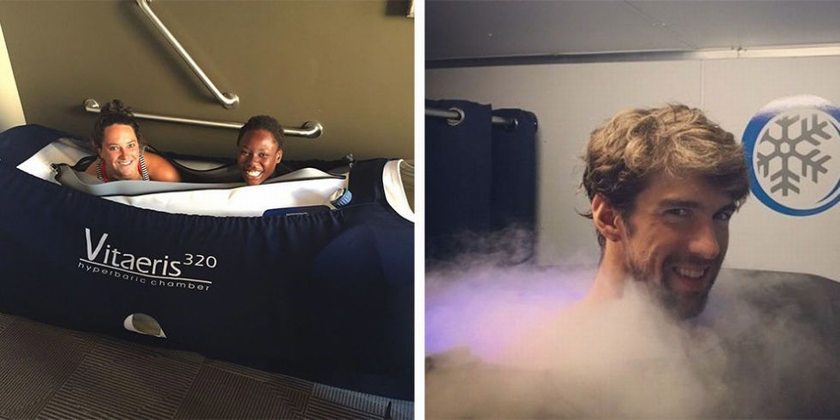From their record-shattering athletic accomplishments to their crazy-toned bodies, everything about Olympians seems superhuman — especially when you realize that you probably couldn’t get off the couch and walk to the kitchen (for more popcorn, duh) in the time it takes Usain Bolt to run 100 meters. (9.81 seconds — ready, set, GO!)
But the talented athletes are, by all accounts, human, which means the rigorous training they undergo does affect their bodies. So while Simone Biles might not feel as sore as we do the morning after spin class, you can bet she’s woken up with achy muscles after a particularly grueling practice.
A healthy body does a pretty good job of healing itself, which is why that soreness doesn’t usually last longer than a day or two. (Thank goodness!) But professional athletes don’t always have the luxury of waiting until they’re back to 100% before they train or compete again, which is why many turn to unusual therapies in hopes of faster recovery and better performance.
From the purple circles all over Michael Phelps’ shoulders to the ice chambers where pros freeze their butts off (almost literally), here we examine six not-so-mainstream treatments practiced by elite athletes — and the research and expert opinions on whether or not they’re worth trying.
Hyperbaric Oxygen Therapy
The Claim: Hyperbaric oxygen therapy (HBOT) involves a chamber that emits 100% oxygen — compared to the typical 21% oxygen found in the air we breathe — with increased pressure. One of its purposes is to accelerate wound healing, because oxygen supports the growth of new blood vessels when they’ve been injured from soft tissue damage and chronic, non-healing wounds.
A patient lies inside a tube that’s about 7 feet long. Once sealed inside the chamber, the technician will increase the air pressure up to three times the normal pressure, but the patient will still be able to breathe and talk normally. Each session lasts between 30 minutes to two hours, and patients can pass the time by reading, listening to music, or watching TV.
The Proof: A 2012 review concluded that HBOT “should be considered” for treating various types of infected wounds, including those caused by crash injuries, compromised skin grafts, and thermal burns. On the other hand, a small January 2015 study found that HBOT “showed no benefits” in patients with persistent post-concussion symptoms (PCS) after mild traumatic brain injury. In short: HBOT is not a cure-all; it is more effective in treating some injuries than others.
Hyperbaric chambers require FDA clearance, which means the FDA must review valid scientific evidence supporting a specific use for the device and determine that it’s at least as safe and effective as another legally U.S.-marketed device. While 13 uses of a chamber for HBOT have been cleared by the FDA — including treatment of carbon monoxide poisoning, decompression sickness (aka “the bends”), and thermal burns — sports injuries didn’t make the list.
“This is a new therapy, so it needs further research to demonstrate its validity,” says Heather A. Hausenblas, PhD, professor of kinesiology who specializes in physical activity and healthy aging at Jacksonville University.
The Verdict: These high-pressure chambers can be found in hospitals around the country, including New York Presbyterian and Johns Hopkins Medicine. But because use of HBOT for sports-related aches and pains hasn’t been given the thumbs up from the FDA, sticking to good ol’ fresh air is probably your best option for now.
Regenokine Therapy
The Claim: Regenokine (known as Orthokine outside of the United States) is a medical procedure designed to reduce pain in joints or tissue by increasing that area’s levels of an anti-inflammatory protein called interleukin-1 receptor antagonist protein (IRAP).
Our bodies naturally produce IRAP, so the therapy begins with the patient’s blood being drawn, centrifuged, and incubated over glass beads for 24 hours. This process separates the IRAP serum from the rest of the blood. The serum is then injected into the targeted body part over five to six days.
The Proof: Multiple studies suggest that Regenokine is an effective and low-risk treatment for various joint problems — notably arthritis. (In fact, a similar version of this therapy is often performed on horses with osteoarthritis.)
“There are no significant negatives associated with this procedure — except that its use is very limited in the United States due to lack of FDA approval,” says Luga Podesta, MD, director of sports medicine at St. Charles Orthopedics in East Setauket, New York.
The Verdict: “In my opinion, regenerative cell-based therapies such as Regenokine and Platelet-Rich Plasma (PRP) should be considered in any patient suffering from musculoskeletal injuries of muscle, tendon ligaments, or arthritic joints,” Dr. Podesta says. “There doesn’t appear to be any significant adverse effects or contraindications for this treatment and the treatment appears relatively safe.”
But because this therapy hasn’t received FDA approval in the United States, you may need to travel abroad for treatment. Even Kobe Bryant had to travel to Düsseldorf, Germany, to receive treatment for his right knee back in 2011.
“However, similar or greater increases in IRAP have also been found in bone marrow concentrate, which is readily available in the United States and approved by the FDA,” Podesta adds.
GyroStim
The Claim: This computer-controlled multi-axis chair may look a lot like a carnival Tilt-a-Whirl, but it was actually designed to improve balance and athletic performance, as well as encourage coordination in people with neurological challenges caused by everything from chemotherapy to autism and cerebral palsy (CP).
As the chair rotates up and down and side to side for a few minutes, it’s meant to stimulate the area of the brain responsible for motor function. According its own website, GyroStim is currently available for use at various sports science labs, elite sports training centers, medical/neurological clinics, universities, and military research facilities around the country.
The chair was originally created by an engineer whose daughter was born with CP. He and his wife were told their daughter needed her vestibular system stimulated — the system that coordinates movement with balance — through therapeutic exercises in order to improve her ability to walk.
The Proof: There’s a disclaimer on the website that states: “The public may encounter media coverage and testimonials referencing GyroStim’s role in addressing balance-related issues that manifest with concussion, TBI (traumatic brain injury), or other neurological conditions, however, GyroStim is not intended for use in the diagnosis or cure of disease or other condition. “
This device has not yet been evaluated by the FDA.
The Verdict: “I’m always cautious when it comes to new products introducing health-related claims that may not have been tested under scientific scrutiny,” says Harry Kerasidis, MD, founder and medical director for the sports concussion management platform XLNTbrain in Maryland. “Particularly with the brain — the most important organ in the body — unusual angles and spins could delay or even cause symptoms related to concussion.”
But he advises to keep an open mind.
“As a neurologist, I recognize the brain is the new frontier for research and development, and many times products and solutions come to the market around the medical research route,” Dr. Kerasidis says. “As consumers, before we do anything to the brain, engage your prefrontal cortex and think. Weigh the pros and cons and make good choices.”
Stem Cell Therapy
Getty Images
The Claim: Stem cells are the body’s main cells responsible for repairing damaged tissue in order to reduce inflammation. To perform this therapy, stem cells are extracted from the bone marrow of either the adult patient or a donor, and are then injected into the patient’s injured areas.
The Proof: A February 2014 study concluded that cell-based therapies and regenerative medicine “offer safe and potentially efficacious treatment for sports-related musculoskeletal injuries.”
However, the FDA has issued a warning about various stem cell therapies. To date, it has only approved one type of stem cell product — Hemacord, a cord blood-derived product manufactured by the New York Blood Center and used for specified indications in patients with disorders affecting the body’s blood-forming system.
“The FDA is concerned that the hope that patients have for cures not yet available may leave them vulnerable to unscrupulous providers of stem cell treatments that are illegal and potentially harmful,” the FDA stated in a press release.
The Verdict: Podesta believes this type of therapy could be worth a shot, but it remains to be seen whether or not more therapies will be approved.
Cupping
The Claim: By now you’ve probably heard more than you ever wanted to about cupping, but here’s the gist in case you missed it:
“Cupping is a low-cost, non-invasive, overall safe form of therapy meant to promote natural body healing,” explains Ilan Danan, MD, neurologist at the Kerlan-Jobe Center for Sports Neurology and Pain Medicine at Kerlan-Jobe Orthopaedic Clinic in Los Angeles.
The treatment, which is a form of acupuncture, involves lighting a flammable liquid inside a cup made from either glass, bamboo, or earthenware. When the flames goes out, the rim of the cup is placed on sore muscles for five to 10 minutes, creating a vacuum-like environment in order to promote blood flow, stimulate muscle activity, and decrease inflammation.
“It’s important to know, however, that cupping can result in bruising to the skin, lasting up to several days,” adds Dr. Danan, hence the giant purple spots Michael Phelps sported during the first few days of the 2016 Olympics.
The Proof: While this treatment dates back thousands of years to ancient Eastern medicine, there’s still “very limited scientific evidence to date,” Danan adds.
That said, a July 2014 review of 16 trials and 921 participants suggested “a potential positive short-term effect of cupping therapy on reducing pain intensity compared with no treatment, heat therapy, usual care, or conventional drugs.”
“It’s not well understood how cupping may work,” Podesta says. “It’s also felt that a significant placebo effect may play a part in the perceived and reported benefits of this ancient treatment.”
The Verdict: “I’ve found that for many of my patients dealing with chronic pain, it has proven to be beneficial as an adjunct therapy,” Danan says. “So I would say that, yes, cupping is worth trying in an effort to relieve muscle tightness and minimize muscular or myofascial pain.”
Podesta agrees: “In my opinion, cupping is worth a try to help recover from strenuous activities, loosen tight and sore muscles, and promote relaxation — even if the benefits may be secondary to the placebo effect of the treatment.”
Whole Body Cryotherapy
The Claim: Whole body cryotherapy (WBC) is a super-cooling treatment that supporters claim can treat chronic joint pain as well as numerous other conditions, such as anxiety, weight gain, migraines, insomnia, rheumatoid arthritis, and Alzheimer’s disease.
Each cryotherapy session lasts between two to four minutes and involves exposing the body to extremely low temperatures — ranging from -200 to -300 degrees Fahrenheit — that are generated by liquid nitrogen. The freeze tank is either made for one individual, where the person’s torso and legs are confined but their head is exposed at room temperature, or for several people, where the users enter a small room where they can sit or stand.
The Proof: When it comes to body-benefiting research on WBC, there isn’t a lot of it.
“There’s insufficient evidence to determine whether WBC reduces self-reported muscle soreness, or improves subjective recovery, after exercise compared with passive rest or no WBC in physically active young adult males,” Dr. Hausenblas says. “And there’s no evidence on the use of this intervention in females or elite athletes.”
In fact, WBC received the big chill from the Food and Drug Administration (FDA) in July when it announced the therapy lacks evidence to treat joint and body pain, improve recovery and soreness after workouts, improve blood circulation, and increase metabolism.
“Based on purported health benefits seen in many promotions for cryotherapy spas, consumers may incorrectly believe the FDA has cleared or approved WBC devices as safe and effective to treat medical conditions,” says Aron Yustein, MD, a medical officer in the FDA’s Center for Devices and Radiological Health, in a press release. “That’s not the case.”
The FDA is also concerned about potential hazards, including asphyxiation. In October 2015, a 24-year-old Las Vegas spa employee died from asphyxia caused by low oxygen levels in a chilled cryotherapy chamber.
The Verdict: “Further high-quality, well-reported research in this area is required and must provide detailed reporting of adverse events,” Hausenblas says.
You don’t necessarily have to give WBC the cold shoulder, but there’s still not enough research available to be sure it does your body good.











